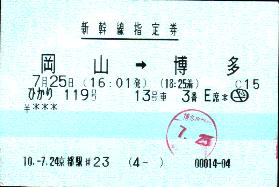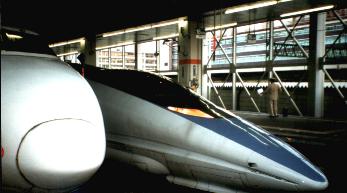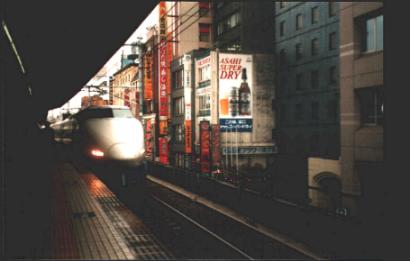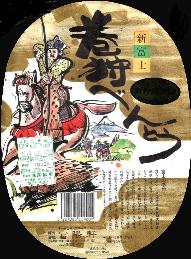| JAPAN, JULY 1998 - On my travel through Japan, I’ve used the shinkansen (or ‘bullet train’) for large distance travel. This is an expensive way of travel, but there are many advantages : it’s very fast (it runs 300 km/h to 450 km/h), it’s very comfortable, and it’s an exiting experience.
|
As in many countries, traveling by train in Japan adds to your travel experience. It’s a way to learn something about the locals, just by observing them or even try to start a conversation with them if possible. And it’s a great way to view a variety of landscapes in a short amount of time. The shinkansen trains are very well organised. They run “on the dot” : when your ticket says 14h34, it means 14h34, not 14h35 ! On the several occasions I’ve taken shinkansen, this appeared to be true. But the organisation goes way beyond being punctual (although no other country in the world can beat them on this point)…
 |
 |
It all starts buying tickets. Of course this is highly computerised process. All seats are numbered – most people reserve their seat in advance, although this is not necessary, it’s highly recommended just because most people do, there are hardly any free non-reserved seats. A booking can be made several days in advance and you can easily book several train trips at a time. When you have figured out what platform you should be on (we used to rely on the time of departure to find the platform), you should join the queue for your carriage (also mentionned on your ticket somewhere). On the platform the carriage number is shown by large numbers on the floor – people queue behind this numbers (just as you would queue in the postoffice). There also is big yellow line – this is not to be crossed at any time. Sometimes a shinkansen passes through the station at a big speed – you could be blown away by the air movement when to close. Some minutes before the time mentioned by the ticket, the train arrives. The door of your carriage opens exactly above the number on the platform (not one meter to the left or right). When everyone has boarded, after allowing people to get off, the train departs exactly on the time the ticket states. Don’t forget they also load the catering and other stuff, and change personell during that time. It’s already truly amazing.

Once you’re inside the train, just find your seat and you’re ready for the fast ride. The display above each door shows constantly where you are, what distance is left to the next stop, and the speed of the train. The doors are sliding doors, that (of course) open and close automatically. The seats are comfortable and of course everything is airconditioned (which is not a luxury in July !). At some point during the trip the guard of the train comes inside your carriage. He first greets every one by making a bow. He repeats this when he leaves you’re carriage, as a sign of respect and meaning to say “thank you” to everyone. Of course you can also drink something and eat something on the train. Very popular, and very tasteful, are the “bento-boxes“. These are carton or wooden boxes that come in large variety of Japanese food. You can buy them in the lunch carriage, but they are also distributed by someone of the staff coming along, shouting “bento, bento”…

When you finally arrive at your end point, sometimes 500 kilometres further, you’re ready to get into the crowds, and will probably discover a new world again.
